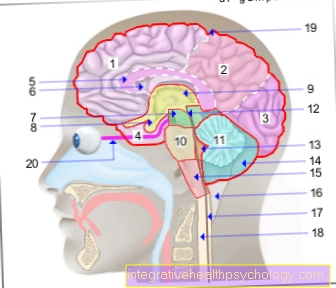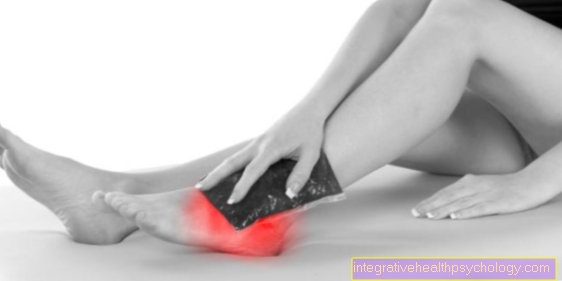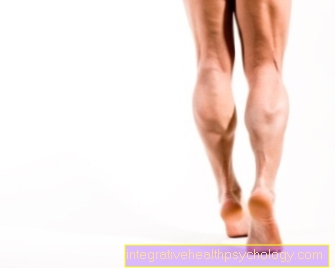fitness
Synonyms in the broadest sense
Fitness training, strength training, endurance training, health-oriented fitness training, health, physical fitness,
English: physical fitness
definition
In general, fitness is defined as a person's fitness for life and the ability to perform intended actions.
In the Duden dictionary, the term fitness is reduced to the physiological aspect and is considered to be good physical condition or performance.

Concept of fitness
"Fitness is a balanced measure of optimal, but not maximum, performance in all components of performance, the absence of illnesses, psychological and social well-being that people are aware of and enable them to perform that correspond to their best personal intentions"
Here you will find an overview of the exercises for individual muscle groups
- Arm training
- Abdominal training
- Leg training
- Chest workout
- Back muscle training
- Shoulder training
- Neck muscle training
Definition of fitness training
Fitness training is considered to be training with the aim of maintaining or improving motor fitness.
Since the founding of commercial sports providers in the last century, fitness training has established itself as a sport, and through numerous fitness movements it finds its way into all ages and levels of ability. Both bodybuilding and training to maintain motor skills in old age are part of fitness training and thus clarify the comprehensive concept of fitness training. Fitness is primarily characterized by the numerous fitness tests that make the maintenance or improvement of athletic performance measurable.
Common usage
Fitness comes from the English (to fit) and means, suitable, appropriate, decent, suitable, capable or ready. It is therefore not surprising why the term “being fit” is also used for non-sporty statements. Example: Are you fit for physics work? He is fit in the computer program etc.
Fitness and health
According to the WHO (World Health Organization), health is a state of complete physical, social and psychological well-being and not just being free from disease.
There are similarities with the concept of fitness, but in addition to the state of well-being, the ability to perform is included here. A person who is healthy according to WHO does not have to be fit yet, and someone who takes a fitness test with a high score does not necessarily have to be healthy.
The transition between fitness training and health training is fluid.
Health training is fitness training, but fitness training is not always health training.
Health training:
- Health training is carried out by someone whose lifestyle has become too comfortable and to counteract the risk factor inactivity.
- Health training thus has a compensatory character.
Fitness training:
- Fitness training serves to improve and stabilize performance
- In addition to its compensatory nature, fitness training is seen as a performance improvement.
Motifs for fitness
Fitness training is u. a. instrumentalized for the following goals:
- Maintaining and increasing professional participation
- Wellbeing
- Disease prevention
- Increase motor performance
- Achieve ideals of beauty
- Socializing
Fitness training goals
The following goals can be achieved with targeted fitness training:
- Optimization of the cardiovascular system through targeted endurance training
- Training of the muscles
- Maintain mobility through targeted stretching
- Maintain agility through coordination training
- Balance the nerve stress through targeted relaxation techniques.
Fitness and strength training
introduction
Due to the increasing mechanization of our society, the most common causes of lifestyle diseases are caused by a lack of exercise. This has a negative effect on the cardiovascular system and the mobility of our musculoskeletal system. Back pain and osteoporosis are among the most common orthopedic diseases today.
Since muscle strength decreases steadily from the age of 30, targeted training of the muscle groups should not only be carried out in the sense of body shaping. In addition, strength is a basis for almost all types of sport. Thus, good training of the core muscles, back muscles and abdominal muscles is a prerequisite for tennis. By not doing compensatory strength training in game sports, muscular imbalances can arise. A typical example is back pain caused by serving in tennis.
Terms in strength training
Beginners in the field of strength training often fail because of the technical language. This is often due to the fact that strength training terminology is misused many times, and not just by lay people.
Here are the definitions:
The terms sentence and series are used synonymously. A sentence thus corresponds to a series.
The repetition indicates the number of repetitions within a set or a series. 12 repetitions mean that the athlete performs the movement 12 times.
Note:
However, the concept of sentence training is different:
In set training, one set / series is completed on different devices one after the other. Example. A bench press series, a leg press series, a lat pull series, and a butterfly series. One series / set is carried out for each device. This run on the devices is then referred to as sentence training and is carried out several times in a row.
During station training, all sets / series are completed one after the other on one device. The term block series training is also used in the literature.
Circle and circuit training
A circle training consists mainly of 6 to 18 different exercises, on which only one set / series is carried out, and then after a certain time you switch to the next exercise station. The stations should be chosen in such a way that different muscle groups are always loaded alternately.
In addition to maintaining and improving strength (endurance), speed (endurance) and endurance, the goals of circle training are to improve mobility with exercises through stretching.
The term circuit training is linguistically questionable and is therefore not used in training.
Effects of strength training
The positive effects of regular strength training in the area of fitness can be divided into:
Preventive goals:
- Reduction of the risk of injury and wear and tear in sports and everyday life.
- Stabilization of the passive musculoskeletal system
- Prevention of back pain
- Prevention of muscular imbalances in sports
- Improvement of the resilience of the musculoskeletal system
Rehabilitation goals:
- Accelerating rehabilitation after injuries
- Accelerated build-up of muscles after injuries
- Performance improvement:
- The general strength performance is improved through targeted strength training.
psychological effects:
- Improved self-confidence
- Increase in wellbeing
aesthetic effects:
- Body shaping through muscle growth
- Burning fat through weight training
Strength as a training goal
The development of strength skills is fundamental to the field of fitness.
Force can be understood in the biological sense as muscle work, and in the physical sense as the product of mass and acceleration. Basis for the manifestations of the Rapid strength, reactive strength and the Strength endurance is the maximum strength. It can be further subdivided into dynamic-concentric (overcoming), static and dynamic-eccentric (yielding) maximum force.
Further information on this topic is available at: Strength training
Strength training methods in fitness training
The strength training methods in the field of fitness are understood as not (highly) performance-oriented methods.
Sports scientists differentiate these methods of strength training in 1.Methods of complex force development and 2. Methods of differentiated force development.
1. The method of complex strength development is used for general strength training or muscle building for beginners and less powerful athletes with the aim of improving general performance or creating a foundation for further strength skills. This method is used in school sports, to promote health and in sports games.
Principles for training complex strength skills:
- 8-12 reps per set
- Exercises on fixed equipment, no free weight training
- Variable choice of exercise
- Use the circle training method
- Breaks between exercises approx. 2 minutes
2. The method of differentiated force development is based on the development of the complex methods and is divided into the following areas:
- Method of maximum strength
- Method of strength endurance
- Method of quick strength
- Reactive force method
risk of injury
The methods for improving quick strength and reactive strength are special methods for the high-performance area.
Recreational athletes are advised not to use these methods during training, as there is a high risk of injury and a health hazard.
Methods
Method of repeated submaximal application of force
intensity: 60- 75%
Repetitions: 8-12
Number of sets: 4-5
Breaks: 2 min.
Number of exercises: 10
Execution speed: slowly
Training effect: Muscle building
Method of repeated exhaustive use of force
Intensity: 80- 90%
Repetitions: 6-8
Number of sets: 4-5
Breaks: 3 min.
Number of exercises: 10
Execution speed: slowly to briskly
Training effect: Muscle building / intramuscular coordination
Method of strength endurance
Intensity: 40- 60%
Repetitions: 20- 40
Number of sets: 6- 8
Breaks: 30-60 sec.
Number of exercises: 5-10
Execution speed: slowly
Training effect: Strength endurance
Fitness and endurance training
introduction
Targeted endurance training is undoubtedly the most important factor in fitness training. The improvement in endurance not only has a positive effect on performance, but also prevents degenerative cardiovascular diseases. These are among the most common diseases in the western world and occupy first place in the death statistics. Exercising abstinence increases the risk of arteriosclerosis, which is a cause of cardiovascular diseases. A fitness-oriented endurance training prevents the risk factors of a heart attack.
In addition, endurance training, in addition to strength training and speed training, is often a prerequisite for various game sports (tennis, handball, football, hockey, etc.).
Effects of regular endurance training
In order to illustrate the positive effects of endurance training, the effects are described in detail below.
heart
- Falling heart rate at rest and exercise
- Enlargement of the maximum stroke volume
- Enlargement of the heart muscle
- The work of the heart is economized
- Improved maximum oxygen uptake
Musculature
- Blood circulation is improved
- Improved oxygen uptake
blood
- Blood vessels expand (reduced risk of arteriosclerosis)
- Increased oxygen transport through the blood
- The risk of thrombosis is reduced
lung
- Minute ventilation is increased.
- Breathing is economized during stress
immune system
- The immune system is strengthened
- The risk of tumor formation is reduced
psyche
- Reduce stress
- The release of endorphins creates positive feelings
- Faster regeneration
- Strengthening self-confidence
Bodybuilding
Bodybuilding is a form of body modeling through targeted muscle building training and dietary measures.
Detailed information on this topic:
- Bodybuilding
- Natural bodybuilding - what is it?
Back training and fitness
Due to a lack of exercise and incorrect posture, back pain is the most common complaint on the musculoskeletal system. Back pain is synonymous with pain in the region of the sacrum. In English literature they are often referred to as "low back pain". As you can see from the various terms above, back pain can have different origins. The cause does not always have to be in the back area.
Information on training the back muscle is available at: Back training
Stretching and fitness
In addition to strength, endurance and speed, mobility is a sub-area of the conditioning skills and must therefore be included in every conditioning training plan.
Through targeted stretching, positive effects of adaptation can be achieved in the organism. However, stretching is a controversial topic in sports science and current knowledge can soon be overtaken by new scientific research.
For detailed information on this topic, visit our topic: Stretching
How can I motivate myself to be fit?
Everyone knows those days when it is particularly difficult to motivate oneself to exercise. There are a few tips that can help specifically:
-
Find the right sport, be it running, strength training, ball sports or functional training
-
Make yourself aware of why you are doing sports! Reduction of stress, balance, weight loss etc.
-
Find a sports friend and meet up for training
-
Set goals that are actually achievable. That means you should start with small goals.
-
Prepare your workout clothes the night before or take them to work if you want to train in the evening. This will reduce obstacles and excuses!
-
Sometimes it helps to take the direct route from work to sport. Once you lie on the couch, it is harder to get up again.
-
Listen to music that is fun while exercising
-
Reward yourself every now and then. A piece of chocolate or a beer can occasionally be enjoyed.
-
Buy suitable sports equipment, e.g. Fitness watch or bluetooth headphones. That motivates!
It basically helps to keep reminding yourself what you are doing the training for. Targeted rewards, cool training equipment, a training partner and the other tricks can help to motivate yourself again and again.
Fitness equipment
What is a fitness bracelet / fitness tracker?
The fitness bracelet, also known as a fitness tracker, is an invention that is booming on the health market. It is a bracelet with a touch display. A fitness bracelet tracks various data, for example distance, time, calories burned, heart rate, steps, floors climbed or sleep behavior. Fitness wristbands have different functions and can sometimes even replace a personal trainer.
A fitness armband pangs the wearer until it finally moves on. There are numerous products on the market with different value for money. Even the cheaper products offer many functions. Basics are pedometers, calorie trackers and sleep analysis. More expensive fitness trackers are also used with GPS and heart rate measurement. Possible functions are also notifications about missed calls, SMS or emails, music remote control and social apps. Some devices are equipped with apps for Android, iOS or Windows Phone. Many fitness trackers are also waterproof.
Read more on the topic: Fitness bracelet
What is a fitness bike?
A fitness bike is a special type of bike. It's kind of a mixture of a racing bike and a mountain bike. A fitness bike enables riding on paved and unpaved routes / paths. Most fitness bikes are equipped with straight handlebars. This means that you can sit upright in contrast to a racing bike. A fitness bike is characterized by a tire size of 28 inches, which enables high speed. This aspect is similar to the racing bike, while mountain bikes mostly have tire sizes of 26 inches. This means that a mountain bike has a lower rolling resistance. Fitness bikes are not only fast, but also very light. They have no mudguards, luggage racks, chain guards or lighting elements. Fitness bikes have frames made of aluminum or carbon.
In addition, most fitness bikes have a derailleur of up to 30 gears. In order to find the right fitness bike, it is important to adapt the bike to your own needs. The frame size has to fit and the saddle has to be right. Since you adopt a sporty posture on a fitness bike, narrower saddles are recommended. One says with a fitness bike: seat hump width (that is the area between the center of the two seat humps) + 1 cm = corresponds to the appropriate saddle width. For the individual frame size, multiply your own stride length (in cm) by the value 0.66. In appropriate shops there are trained staff who can help with the right choice of frame size and saddle.
What do I need fitness gloves for?
Fitness gloves are sold by many sports brand manufacturers and are becoming increasingly popular. The main function of these gloves is to ensure a secure hold in the hand. This applies to free weights and barbells. Fitness gloves are great for lifting heavy weights. Products with padded palms are particularly comfortable to wear.
There are many products with a ventilation function among fitness gloves. This means that the fabric absorbs moisture to keep your hands dry during exercise. With damp hands it is more difficult to keep weights technically clean for a long time. Fitness gloves also prevent pressure points and calluses from developing on the inside of the hand. There are also special models that surround the wrist with reinforced material and are intended to protect the wrist in this way.
Read more on the topic: Fitness gloves
Which fitness bands do I need?
Fitness bands are among the most versatile and affordable fitness accessories. The classic fitness bands are colorful, elastic bands made of latex that are one to three meters long. The choice of fitness bands depends on the intended use. Fitness bands are suitable for everything between general exercise, physiotherapy and targeted strength training. Red ribbons are mostly used for physiotherapy, which means medium-strong ribbons. The colors of the fitness bands from most manufacturers correspond to the colors of the Thera bands (original fitness bands).
That means yellow bands have a slight resistance, red bands have a medium-strong resistance, green bands a strong one and black bands provide a super strong resistance. A red band is usually sufficient for physical therapy exercises, while strength training often starts with light or medium-strength bands. With the training, the resistance can gradually be increased, so that it makes sense to have different fitness bands to choose from during strength training.
What do I need a fascia roll for?
A fascia roll is a self-massage device made of hard foam that is used in many ways. In addition to its use in physiotherapy and sports medicine, the fascia roller has become indispensable in the fitness area. The fascia roll is ideal for warm-up or cool-down. When warming up, the fascia roller can help the muscles slide better by rolling out the muscles on the roller. This allows you to achieve improved body control throughout the workout.
In the cool-down, the fascia roll is used more intensively, the roll-out takes place more slowly and longer. In addition, the fascia roll can also be used for certain fitness exercises, for example holding exercises or stomach, legs and buttocks. Depending on your preference, you can use the fascia roll for warming up, training or cooling down. Another beneficial effect is the pain relief. Do not put pain in the fascia tissue, which is rich in pain receptors. Regular training sessions with the device help to loosen stuck fascia.
Read more on the topic: Fascia training
What is a vibration plate used for?
Vibration plates can be found in many fitness studios. They have a frequency range of five to sixty hertz and give the user a good shake. One option is to simply stand on the plate for a few minutes. The vibration plate forces muscle contractions on our body, which promote the development of muscles. The body uses these muscle movements to maintain balance. This means that the movements on the vibration plate are passive movements.
Therefore, vibration training is exhausting even without active movements. If you want to achieve more, you can combine active and passive movements. This works by simply performing classic muscle building exercises on the vibration plate. There the exercises are more difficult, which increases performance and improves coordination and balance. Training with the vibration plate is particularly effective because it addresses the deep muscles, which are otherwise less used during training.
Read more on the topic: Vibration plate
Diet and fitness
In fact, diet affects our fitness more than many think. A healthy diet recommends a composition of 45% carbohydrates, 30% fats (of which 10% each from saturated fats, monounsaturated fats and polyunsaturated fats) and 25% from protein. Competitive athletes, for example marathon runners, have a significantly increased need for carbohydrates, while strength athletes have an enormous need for protein. Strength athletes are recommended 1.4 to 1.8 grams of protein per kilogram of body weight per day.
It is important to eat well. This means that you are consuming good carbohydrates, such as whole grains, cooked vegetables, oatmeal or parboiled / basmati rice. Soft-boiled pasta, sweets and white rice should be avoided, as these foods cause blood sugar to drop quickly, causing hypoglycaemia. A lot of vegetables, fruit, fish, eggs, etc. are on the menu. Certain foods, such as citrus fruits (grapefruit, lemon) and spices such as chilli or pepper, are also supposed to stimulate fat burning.
In order to be efficient, the body needs high-quality nutrients, vitamins and trace elements. In fitness it is important to drink enough. You should drink at least two liters of water a day, significantly more when you workout. A healthy, balanced diet can have a positive effect on fitness and body weight.
Read more on the topic: Diet and exercise
Are supplements / fitness boosters useful in the fitness area?
The so-called fitness boosters are now part of the basic equipment of many exercisers. Fitness boosters, also known as training boosters, pre-workout boosters or just boosters, are dietary supplements that are freely available in stores. These are nutritional supplements that are supposed to increase physical performance during sport and to stimulate fat burning and muscle building. Examples of fitness boosters are protein powder, amino acids such as L-carnitine or L-arginine or creatine.
Protein-containing products are very useful after a workout. They promote muscle building. Other dietary supplements can simply be taken once a day in the form of a capsule, for example creatine or L-carnitine. In addition to training and supplements, diet plays an important role in achieving your fitness goals. Not all fitness boosters are low in calories and can be eaten from morning to evening. In order to achieve the desired body, fitness boosters should be used specifically and a balanced diet.
Read more on the topic: Supplements
Do fitness bars make sense?
Fitness bars are popular snacks among athletes. They are often eaten as a snack between meals. An ideal fitness bar supplies the body with energy and nutrients. However, there are hidden sugar traps in many fitness bars. Even if the products are called "fitness bars", "low-carb bars" or something similar, it is worth checking the nutritional values.
A fitness bar should contain as little sugar as possible and plenty of protein. A bar with lots of protein can be eaten as a snack after exercise and serves its purpose. If numerous high-carbon, high-sugar "fitness bars" are eaten during the day, the snack is pointless in terms of "fitness".
Further information on the subject can be found at: Fitness bars
I want to set up a fitness room at home - what do I need?
Having your own fitness room at home can deliver tons of benefits. You save the gym fees, looking for a parking space, you are flexible in terms of time and you can make exactly the purchases that interest you. As basic equipment for strength training in your own fitness room, you initially only need a few basics.
You need something to lift. That means two dumbbells. It is best to buy dumbbells, which you can supplement with weight plates so that you can increase and adapt to the different muscle groups. A weight bench provides a secure basis for many exercises and is certainly a good investment for your own fitness room.
Many exercisers also buy a pull-up bar. This is ideal for back training and leg lifting as an abdominal exercise. Depending on the space in the fitness room, there are different models, for example a door bar or a pull-up bar for wall mounting. In addition, every training room should have an exercise mat. These can be used for floor exercises and for stretching after training. To keep the room tidy, you can place a dumbbell stand on the wall and, depending on the model, load it with other devices, such as medicine balls, fascia rolls or kettle belts.
Read more on this topic: Gym
What is Aesthetic Fitness?
Aesthetic Fitness describes a modern fitness style of many gym goers. People want to look beautiful and muscular. In contrast to classic bodybuilding, Aesthetic Fitness strives for a defined, muscular body that contains less muscle mass in comparison. The goal is body design that looks beautiful, just right, so to speak.
To achieve this goal, most people regularly go to the gym and do strength training for all muscle groups, i.e. the whole body. You can also do aesthetic fitness at home with fitness videos, for example HIIT (high intensity interval training) or “Freeletics”, which means targeted outdoor fitness exercises.
More information can be found here: Aesthetic Fitness
What does a fitness economist do?
Fitness economists can be found in the leadership and management level of fitness studios or wellness facilities. A fitness economist takes care of the organization of the company, human resources, marketing and sales. An important aspect is the motivation of the team and the fitness trainer. Fitness economists are able to plan and carry out exercise units such as training plans and courses. This means that a fitness economist can give an individual in the gym practical and theoretical instruction while training on the machines.
It is essential to check the functionality of the exercises and to show the trainee corrections to the exercises. One task is to conduct fitness tests. Physical fitness, flexibility and endurance are examined. Such tests can show the trainee strengths and weaknesses and help to set goals and to create an individual training plan based on the test results. Caring for customers is an important aspect of the day-to-day work of a fitness economist. This also includes advice on health, sports and nutrition issues.
Read more on the topic: Fitness economist
What is a fitness model?
Fitness models are models from the fitness sector. It is often so-called “influencers”, i.e. fitness-oriented people, who have gained popularity through the Instagram app. Fitness models present themselves on Instagram, they show workouts, post photos and give fitness and / or recipe ideas (fitness food).
Famous fitness models are sponsored by fitness food brands, protein shakes, protein bars, etc., and sportswear manufacturers. Many fitness models show up at fitness fairs. There are also fitness models who sell their own fitness apps. There they show videos of workouts, give nutrition plans and instruct their “followers” to lose weight and build muscle, in short to get fit.





























